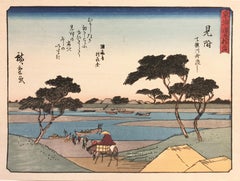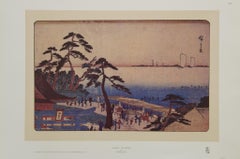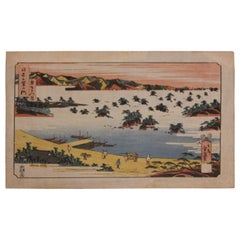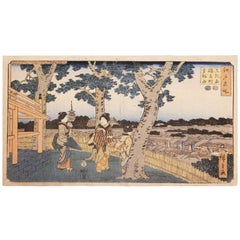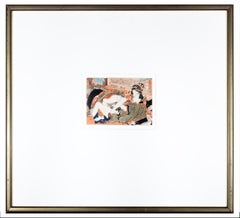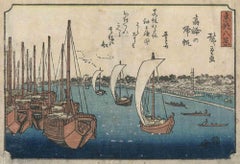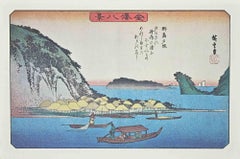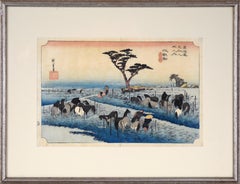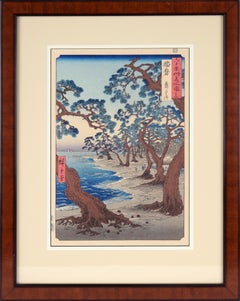Utagawa Hiroshige (Ando Hiroshige) Prints and Multiples
Born in Edo as Tokutaro Ando, Utagawa Hiroshige (also known as Andō Hiroshige) grew up in a minor samurai family. His father belonged to the firefighting force assigned to Edo Castle. It is here that Hiroshige was given his first exposure to art: legend has it that a fellow fireman tutored him in the Kano school of painting, though Hiroshige’s first official teacher was Rinsai.
Though Hiroshige tried to join Utagawa Toyokuni's studio, he was turned away. In 1811, young Hiroshige entered an apprenticeship with the celebrated Utagawa Toyohiro. After only a year, he was bestowed with the artist name Hiroshige. He soon gave up his role in the fire department to focus entirely on painting and print design. During this time he studied painting, intrigued by the Shijo school. Hiroshige’s artistic genius went largely unnoticed until 1832.
In Hiroshige's groundbreaking series of Japanese woodblock prints, The “53 Stations of the Tokaido” (1832–33), he captured the journey along the Tokaido road, the highway connecting Edo to Kyoto, the imperial capital. With the Tokugawa Shogunate relaxing centuries of age-old restrictions on travel, urban populations embraced travel art and Hiroshige became one of the most prominent and successful ukiyo-e artists. He also produced kacho-e (bird-and-flower pictures) to enormous success. In 1858, at the age of 61, he passed away as a result of the Edo cholera epidemic.
Original Hiroshige woodblock prints continue to convey the beauty of Japan and provide insight into the everyday life of its citizens during the Edo period. The appeal of his tender, lyrical landscapes was not restricted to the Japanese audience. Hiroshige’s work had a profound influence on the Impressionists and Post-Impressionists of Europe: Toulouse-Lautrec was fascinated with Hiroshige’s daring diagonal compositions and inventive use of perspective, while Van Gogh literally copied two of Hiroshige's prints from the famous series, “100 Famous Views of Edo” in oil paint.
Find original Utagawa Hiroshige prints and other art for sale on 1stDibs.
(Biography provided by Robert Azensky Fine Art)
Mid-20th Century Utagawa Hiroshige (Ando Hiroshige) Prints and Multiples
Sumi Ink, Washi Paper
Early 18th Century Utagawa Hiroshige (Ando Hiroshige) Prints and Multiples
Lithograph
1850s Edo Utagawa Hiroshige (Ando Hiroshige) Prints and Multiples
Woodcut
1840s Utagawa Hiroshige (Ando Hiroshige) Prints and Multiples
Woodcut
1850s Edo Utagawa Hiroshige (Ando Hiroshige) Prints and Multiples
Woodcut
Mid-19th Century Edo Utagawa Hiroshige (Ando Hiroshige) Prints and Multiples
Woodcut
1850s Utagawa Hiroshige (Ando Hiroshige) Prints and Multiples
Woodcut
Mid-19th Century Edo Utagawa Hiroshige (Ando Hiroshige) Prints and Multiples
Woodcut
1850s Realist Utagawa Hiroshige (Ando Hiroshige) Prints and Multiples
Ink, Woodcut
1840s Utagawa Hiroshige (Ando Hiroshige) Prints and Multiples
Woodcut
1850s Utagawa Hiroshige (Ando Hiroshige) Prints and Multiples
Woodcut
1850s Utagawa Hiroshige (Ando Hiroshige) Prints and Multiples
Woodcut
Mid-19th Century Modern Utagawa Hiroshige (Ando Hiroshige) Prints and Multiples
Woodcut
Mid-20th Century Modern Utagawa Hiroshige (Ando Hiroshige) Prints and Multiples
Lithograph
1920s Art Deco Utagawa Hiroshige (Ando Hiroshige) Prints and Multiples
Woodcut
1930s Modern Utagawa Hiroshige (Ando Hiroshige) Prints and Multiples
Woodcut
1980s Contemporary Utagawa Hiroshige (Ando Hiroshige) Prints and Multiples
Ink, Handmade Paper, Woodcut
Mid-20th Century Utagawa Hiroshige (Ando Hiroshige) Prints and Multiples
Woodcut
2010s Photorealist Utagawa Hiroshige (Ando Hiroshige) Prints and Multiples
Sumi Ink, Watercolor, Monotype, Photogram, Paper
1890s Edo Utagawa Hiroshige (Ando Hiroshige) Prints and Multiples
Ink, Rice Paper, Woodcut
1860s Edo Utagawa Hiroshige (Ando Hiroshige) Prints and Multiples
Ink, Rice Paper, Woodcut
Mid-19th Century Modern Utagawa Hiroshige (Ando Hiroshige) Prints and Multiples
Woodcut
2010s Contemporary Utagawa Hiroshige (Ando Hiroshige) Prints and Multiples
Lithograph
2010s American Modern Utagawa Hiroshige (Ando Hiroshige) Prints and Multiples
Woodcut
1830s Edo Utagawa Hiroshige (Ando Hiroshige) Prints and Multiples
Woodcut, Rice Paper
1850s Realist Utagawa Hiroshige (Ando Hiroshige) Prints and Multiples
Woodcut, Rice Paper, Ink
1840s Utagawa Hiroshige (Ando Hiroshige) Prints and Multiples
Woodcut
1850s Utagawa Hiroshige (Ando Hiroshige) Prints and Multiples
Woodcut
1850s Utagawa Hiroshige (Ando Hiroshige) Prints and Multiples
Woodcut
1850s Utagawa Hiroshige (Ando Hiroshige) Prints and Multiples
Woodcut
20th Century Edo Utagawa Hiroshige (Ando Hiroshige) Prints and Multiples
Woodcut
20th Century Edo Utagawa Hiroshige (Ando Hiroshige) Prints and Multiples
Woodcut
Mid-20th Century Utagawa Hiroshige (Ando Hiroshige) Prints and Multiples
Sumi Ink, Washi Paper
Mid-20th Century Utagawa Hiroshige (Ando Hiroshige) Prints and Multiples
Sumi Ink, Washi Paper
Mid-20th Century Utagawa Hiroshige (Ando Hiroshige) Prints and Multiples
Sumi Ink, Washi Paper
Mid-20th Century Utagawa Hiroshige (Ando Hiroshige) Prints and Multiples
Sumi Ink, Washi Paper
Utagawa Hiroshige (ando Hiroshige) prints and multiples for sale on 1stDibs.
Artists Similar to Utagawa Hiroshige (Ando Hiroshige)
- 1stDibs ExpertAugust 26, 2024To tell if a Hiroshige print is real, examine the paper. During the Edo period, when Hiroshige produced his original prints, paper was very thin. As a result, if your print is on thick, heavy modern paper, the print is unlikely to be a real original. Due to their age, most originals will also show at least some signs of yellowing and wear. Pristine, pure white paper may indicate a reproduction. You can also compare signatures and text blocks on your print to images of original Hiroshige works published on trusted online resources, such as museum websites. Alternatively, you can have a certified appraiser or knowledgeable art dealer evaluate your print for you. On 1stDibs, explore a collection of Hiroshige prints.
- 1stDibs ExpertMarch 22, 2022There are an estimated 8,000 prints in the body of work produced by Utagawa Hiroshige. The artist made woodblock prints using traditional ukiyo-e techniques. Many of his prints show everyday scenes from the Japanese Edo period. He also created many landscapes. Shop a range of Utagawa Hiroshige art on 1stDibs.
- When was Hiroshige born?1 Answer1stDibs ExpertApril 5, 2022Japanese artist Hiroshige was born in 1797 in Edo (now Tokyo), Japan, and died in 1858. He was best known as a master of ukiyo-e woodblock printing tradition. It is estimated that he created about 8000 prints of everyday life and landscapes of Japan. Shop a selection of Hiroshige pieces from some of the world’s top art dealers on 1stDibs.
